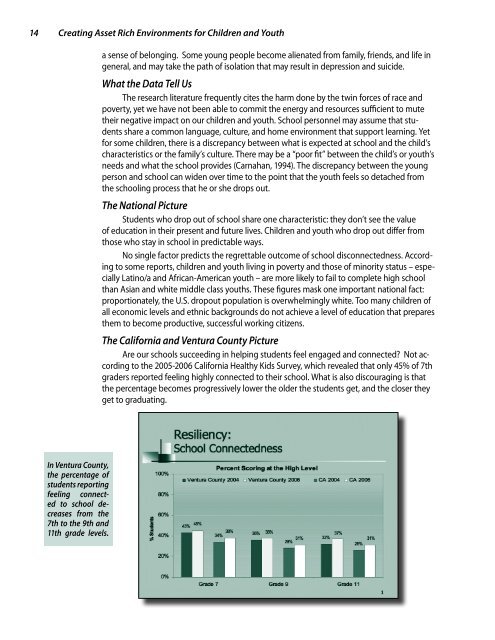for Children and Youth - Ventura County Star
for Children and Youth - Ventura County Star
for Children and Youth - Ventura County Star
You also want an ePaper? Increase the reach of your titles
YUMPU automatically turns print PDFs into web optimized ePapers that Google loves.
14 Creating Asset Rich Environments <strong>for</strong> <strong>Children</strong> <strong>and</strong> <strong>Youth</strong><br />
a sense of belonging. Some young people become alienated from family, friends, <strong>and</strong> life in<br />
general, <strong>and</strong> may take the path of isolation that may result in depression <strong>and</strong> suicide.<br />
What the Data Tell Us<br />
The research literature frequently cites the harm done by the twin <strong>for</strong>ces of race <strong>and</strong><br />
poverty, yet we have not been able to commit the energy <strong>and</strong> resources sufficient to mute<br />
their negative impact on our children <strong>and</strong> youth. School personnel may assume that students<br />
share a common language, culture, <strong>and</strong> home environment that support learning. Yet<br />
<strong>for</strong> some children, there is a discrepancy between what is expected at school <strong>and</strong> the child’s<br />
characteristics or the family’s culture. There may be a “poor fit” between the child’s or youth’s<br />
needs <strong>and</strong> what the school provides (Carnahan, 1994). The discrepancy between the young<br />
person <strong>and</strong> school can widen over time to the point that the youth feels so detached from<br />
the schooling process that he or she drops out.<br />
The National Picture<br />
Students who drop out of school share one characteristic: they don’t see the value<br />
of education in their present <strong>and</strong> future lives. <strong>Children</strong> <strong>and</strong> youth who drop out differ from<br />
those who stay in school in predictable ways.<br />
No single factor predicts the regrettable outcome of school disconnectedness. According<br />
to some reports, children <strong>and</strong> youth living in poverty <strong>and</strong> those of minority status – especially<br />
Latino/a <strong>and</strong> African-American youth – are more likely to fail to complete high school<br />
than Asian <strong>and</strong> white middle class youths. These figures mask one important national fact:<br />
proportionately, the U.S. dropout population is overwhelmingly white. Too many children of<br />
all economic levels <strong>and</strong> ethnic backgrounds do not achieve a level of education that prepares<br />
them to become productive, successful working citizens.<br />
The Cali<strong>for</strong>nia <strong>and</strong> <strong>Ventura</strong> <strong>County</strong> Picture<br />
Are our schools succeeding in helping students feel engaged <strong>and</strong> connected? Not according<br />
to the 2005-2006 Cali<strong>for</strong>nia Healthy Kids Survey, which revealed that only 45% of 7th<br />
graders reported feeling highly connected to their school. What is also discouraging is that<br />
the percentage becomes progressively lower the older the students get, <strong>and</strong> the closer they<br />
get to graduating.<br />
In <strong>Ventura</strong> <strong>County</strong>,<br />
the percentage of<br />
students reporting<br />
feeling connected<br />
to school decreases<br />
from the<br />
7th to the 9th <strong>and</strong><br />
11th grade levels.














